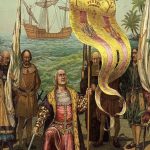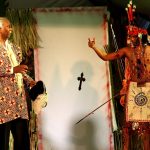Columbus did not discover Caribbean
 Christopher Columbus did not discover the Caribbean
Christopher Columbus did not discover the Caribbean
By Dizzanne Billy From Words in the Bucket
Rather, he introduced the first wave of cultural destruction that would go on to change the region forever.
Today Oct 9), the United States of America recognises Columbus Day. A day which commemorates Christopher Columbus’ arrival in the Americas.
On August 3, 1492, Christopher Columbus set sail from Spain with intentions to find a new route to Asia. On October 12, over two months later, he landed on an island in The Bahamas that he called San Salvador. Guanahani was the original native name for it.
Christopher Columbus did not discover the Caribbean.
This is the truth, though it has been stamped down and twisted to benefit others throughout Caribbean history in order to cover the truth of their mission. Finding riches, conquering territories, and expanding the Kingdom was the focus of his mission, not the evangelisation of the unconverted. Colombus and his crew came, saw, conquered, and then destroyed. They massacred entire cultures and traditions which existed long before intrusion by Europeans.
While the Central and South American mainlands, from Mexico in the north to Peru in the South, had the Olmecs, Mayans, Incas, and Aztecs, the Caribbean islands were inhabited by powerful tribes such as the Taíno, Kalinago, Igneri, Guanahatabey, Garifuna, and much more.
Many tribes existed in the Caribbean
A country existed with many traditions and tribes before Colombus came. He and his crew came, saw, conquered, and then destroyed. They massacred entire cultures and traditions which existed long before intrusion by Europeans.
Take Trinidad. Though the history of the island is most popularly known to begin with the explorations by Christopher Columbus on his third voyage in 1498, in Tobago being tossed between the British, French, Dutch, and Courlanders, and Trinidad being under Spanish control until 1797 and being settled by French colonists, there is a deeper and more ancient history to uncover and recognise. The history of Trinidad and Tobago, as with the rest of the region, truly began with the settlement of its indigenous or first people.
This October, Trinidad and Tobago celebrates the first people in a special way, with a public holiday and a season of festivities, during which indigenous people from around the region of Latin America and the Caribbean will congregate to honour their ancestors.
Trinidad and Tobago, being the southernmost Caribbean island, was the gateway to the rest of the Caribbean. As a result, this country was populated by several indigenous communities although it was predominantly home to Taino and Kalinago communities.
These came to Trinidad from South America in canoes, approximately 7,000 years before the arrival of Columbus. Their population was in excess of 40,000 at the time of Spanish settlement in 1592 and established the Yaio, Nepuyo, Chaima, Warao, Kalipuna, Carinepogoto, Garini, and Aruaca tribes. The descendants of indigenous people today recognise themselves as largely belonging to the Nepuyo tribe.
Culture Lost
Prior to European rule, the indigenous people grew subsistence communities with agriculture-based economies and had well-developed systems of culture, language, religion, and social structure. They were initially nature worshippers. However, under the encomienda system, created by the Spanish to control and regulate indigenous labour and behaviour during colonisation, the indigenous population of Trinidad and Tobago declined massively. Death by disease and murder were both rampant.
Under the guise of protection and religious conversion, the conquistadors and encomenderos enslaved the native people, took their lands, and killed them by the thousands.
Throughout the years, as Spanish missions were established on the island, indigenous culture in Trinidad and Tobago was largely hispanicised, although elements of the original culture managed to survive. Importantly, the Kalinago or Carib Community in Trinidad and Tobago holds on to its use of indigenous flora and fauna, traditional activity, weaving, distinctive masonry skills (identified with thatching and tapia), and planting and processing of cassava and maize.
Language still remains today in the names of places more than 15 places in Trinidad, such as Arima, Arouca, Oropouche, and Guayaguayare. The earliest history of the coastal town of Chaguaramas, Trinidad, is of the Saladoid people, a pre-Colombian community, which occupied the area from 100-400 AD. They named the surrounding areas of Macqueripe and Chacachacare. Even the name Chaguaramas comes from their language, describing the shoreline which was once covered by palm trees.
First people stand their ground in Arima
In 1785, indigenous people residing on missions established in Nepoyo encomienda villages in San Agustin de Arauca, San Pablo de Tacarigua, and Caura were relocated to Arima, in the northeast of Trinidad. This became a location of opposition as the indigenous people settled here to build their community.
The historical overview ‘A Short History of Santa Rosa De Arima’ by Jean Patricia Elie, states, “…Arima was effectively Indian Territory. For most of the 16th and 17th centuries, the district of Arima was the home of the Nepuyo.” From this area, they resisted Spanish rule and put up a fight against Spanish attempts to overtake northern Trinidad.
Today, what remains of the First People are the descendants of the Kalinagos, which still live in Arima. It is here they built the most recognisable traditional community – the Santa Rosa First People’s Community. This Community, having been impacted by cultural assimilation, is now distinguished by Spanish language survival and a strong and enduring Catholic belief system.
It is the last remaining organised group of people in Trinidad and Tobago who live and identify with an indigenous way of life. This extraordinary continuity despite damaging effects of Spanish Conquest and Colonisation is the fundamental factor in the Community’s continuing and powerful indigenous self-identification.
With a Council of Elders, led by a Chief, Queen, and a Pyai (or medicine man), indigenous culture the community seeks to carry on the knowledge of their ancestors and strengthen the influence of traditional culture in modern Trinidad and Tobago. Two of the country’s oldest festivals originated with indigenous tribes: The Santa Rosa Festival in Arima and La Divina Pastora in Siparia. The culture has stood the test of time, regardless of the cruelty of history.
Indigenous cuisine is included in the diet of many Trinbagonians, from cassava bread to corn pastels (presumed to be the original version of the ‘tamale’). Trinbagonian Christmas is not the same without Parang music, a hybrid of Spanish and indigenous musical styles, which developed out of the evangelisation of the first people’s and their conversion to Catholicism.
Setting history straight
29 Archaic sites have been identified, mostly in south Trinidad; most popular is the 7,000-year-old Banwari Trace site, which is the oldest discovered human settlement in the Eastern Caribbean. The earliest settlers are believed to have settled Trinidad from northeastern South America in 5000 BC.
It is therefore incorrect to recognise Christopher Columbus as the apparent ‘saviour’ of the Americas or a brave and valiant traveller who discovered the “New World.” There was a thriving world existing in Latin America and the Caribbean before the arrival of Europeans.
These groups were largely wiped out by the Spanish colonisers under the encomienda system or transformed to fit the European mould. Columbus did not discover the Caribbean. Rather, he introduced the first wave of cultural destruction that would go on to change the region forever.
IMAGES:
Re-enactment of encounter between tribesmen and Europeans | Photo Credit: Santa Rosa First Peoples Community
For more on this story go to: https://www.wordsinthebucket.com/christopher-columbus-did-not-discover-the-caribbean







